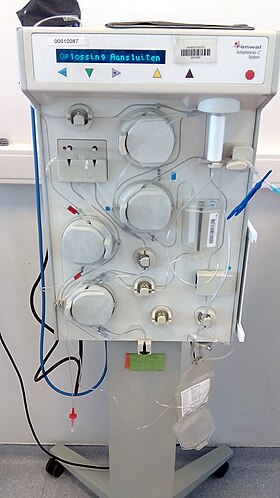
Back استخراج البلازما Arabic Плазмафереза Bulgarian Plasmafèresi Catalan Plazmaferéza Czech Plasmapherese German Plasmaféresis Spanish پلاسمافرز Persian Plasmaphérèse French Plasmafeiréis Irish Plasmaférese Galician
| Plasmapheresis | |
|---|---|
 Plasmapheresis machine | |
| ICD-10-PCS | 6A5 |
| ICD-9-CM | 99.7 |
| MeSH | D010956 |
Plasmapheresis (from the Greek πλάσμα, plasma, something molded, and ἀφαίρεσις aphairesis, taking away) is the removal, treatment, and return or exchange of blood plasma or components thereof from and to the blood circulation. It is thus an extracorporeal therapy, a medical procedure performed outside the body.[1]
Three general types of plasmapheresis can be distinguished:
- Autologous, removing blood plasma, treating it in some way, and returning it to the same person, as a therapy.
- Exchange, a patient's blood plasma is removed, while blood products are given in replacement. This type is called plasma exchange (PE, PLEX, or PEX) or plasma exchange therapy (PET). The removed plasma is discarded and the patient receives replacement donor plasma, albumin, or a combination of albumin and saline (usually 70% albumin and 30% saline).
- Donation, removing blood plasma, separating its components, and returning some of them to the same person, while holding out others to become blood products that this person donates for those in need. In such a plasma donation procedure, blood is removed from the body, blood cells and plasma are separated, and the blood cells are returned, while the plasma is collected and frozen to preserve it for eventual use as fresh frozen plasma or as an ingredient in the manufacture of blood products.[2]
Plasmapheresis of the autologous and exchange types is used to treat a variety of disorders, including those of the immune system, such as Goodpasture's syndrome,[3] Guillain–Barré syndrome, lupus, myasthenia gravis,[4][5] and thrombotic thrombocytopenic purpura.
- ^ Daga Ruiz, D.; Fonseca San Miguel, F.; González de Molina, F.J.; Úbeda-Iglesias, A.; Navas Pérez, A.; Jannone Forés, R. (April 2017). "Plasmapheresis and other extracorporeal filtration techniques in critical patients". Medicina Intensiva. 41 (3): 174–187. doi:10.1016/j.medin.2016.10.005. Retrieved 5 January 2025.
- ^ "Why Donate Plasma". Archived from the original on 25 November 2011. Retrieved 26 September 2011.
- ^ MedlinePlus. "Goodpasture syndrome". U.S. National Library of Medicine. Retrieved 7 April 2013.
- ^ Yazdi, MF; Baghianimoghadam, M; Nazmiyeh, H; Ahmadabadi, AD; Adabi, MA (2012). "Response to plasmapheresis in myasthenia gravis patients: 22 cases report". Revue roumaine de médecine interne. 50 (3): 245–47. PMID 23330293.
- ^ Batocchi, AP; Evoli, A; Di Schino, C; Tonali, P (2000). "Therapeutic apheresis in myasthenia gravis". Therapeutic Apheresis. 4 (4): 275–79. doi:10.1046/j.1526-0968.2000.004004275.x. PMID 10975473.